Design of Additive Manufactured Lattices for Dental Implants Review
VerifiedAdded on 2022/11/13
|37
|10361
|2
Literature Review
AI Summary
This literature review examines the application of additive manufacturing in creating lattice structures with graded porosities for dental implants, aiming to improve bone integration and reduce mechanical mismatch. It discusses the limitations of traditional solid implants, highlighting issues such as bone loss and interface failure due to the high Young's modulus of materials like titanium compared to bone. The review explores the benefits of porous metals in promoting bone ingrowth and mitigating stress shielding, referencing various studies on lattice designs, fabrication methods, and material properties. It also addresses the importance of stress transfer at the bone-implant interface and the potential of optimized lattice geometries to enhance implant success. The review concludes by emphasizing the role of additive manufacturing in producing complex geometries that can improve the long-term performance and biocompatibility of dental implants. Desklib provides students access to similar solved assignments.
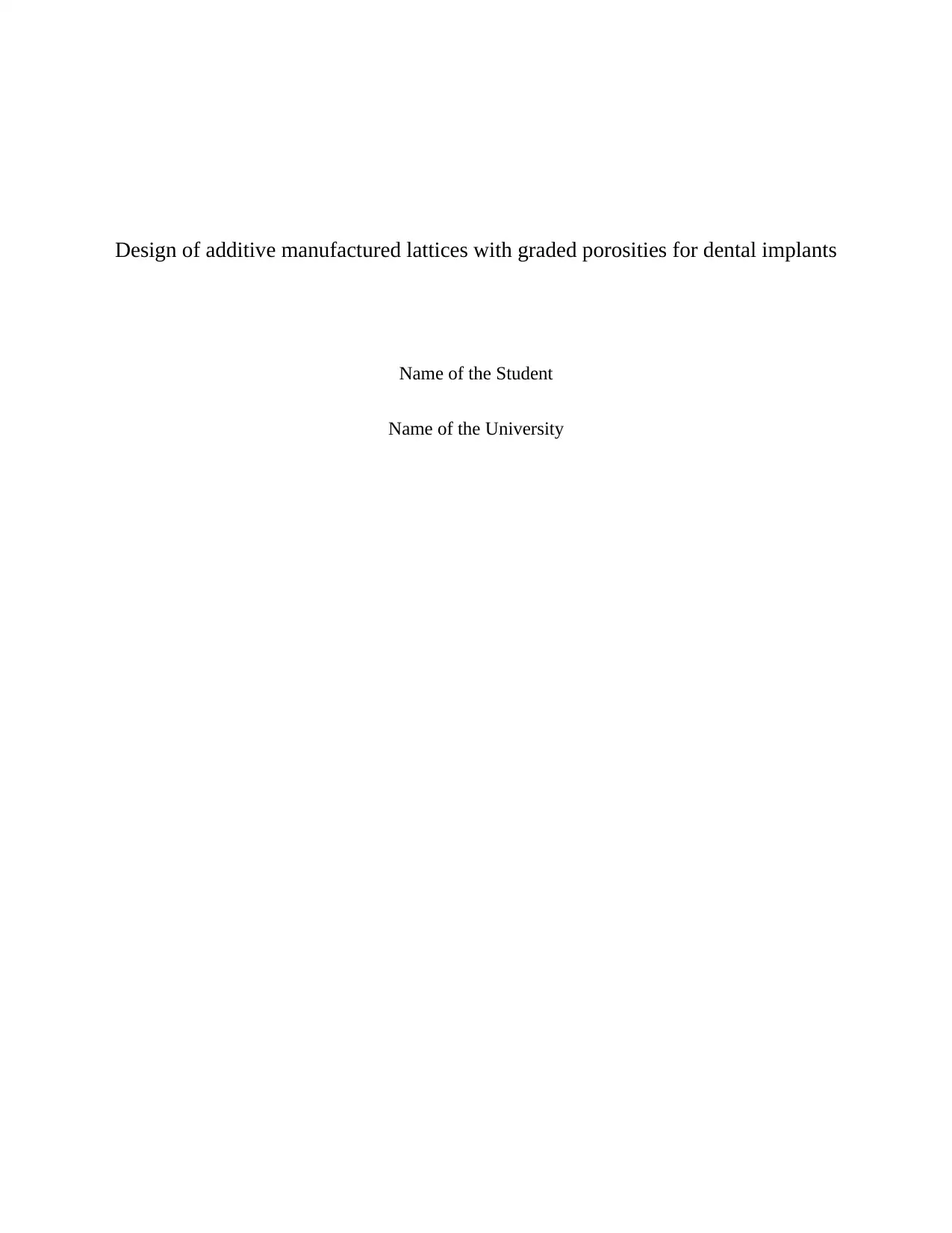
Design of additive manufactured lattices with graded porosities for dental implants
Name of the Student
Name of the University
Name of the Student
Name of the University
Paraphrase This Document
Need a fresh take? Get an instant paraphrase of this document with our AI Paraphraser

Table of Contents
Chapter 1: Introduction....................................................................................................................4
1.1 Background.......................................................................................................................4
1.2 Aim, Objectives and Research Questions.........................................................................7
1.3 Research Structure............................................................................................................7
Chapter 2: Literature Review...........................................................................................................9
2.1 Dental Implants......................................................................................................................9
2.2 Design Optimization of Dental Implants.............................................................................13
2.3. Lattice Structure ..............................................................................................................17
Chapter 3: Research Methodology................................................................................................22
Chapter 4: Data findings and analysis...........................................................................................26
4.1 Qualitative Data analysis.....................................................................................................26
Chapter 5: Conclusion...................................................................................................................31
5.1 Conclusion...........................................................................................................................31
5.2 Future Work.........................................................................................................................32
References......................................................................................................................................34
Chapter 1: Introduction....................................................................................................................4
1.1 Background.......................................................................................................................4
1.2 Aim, Objectives and Research Questions.........................................................................7
1.3 Research Structure............................................................................................................7
Chapter 2: Literature Review...........................................................................................................9
2.1 Dental Implants......................................................................................................................9
2.2 Design Optimization of Dental Implants.............................................................................13
2.3. Lattice Structure ..............................................................................................................17
Chapter 3: Research Methodology................................................................................................22
Chapter 4: Data findings and analysis...........................................................................................26
4.1 Qualitative Data analysis.....................................................................................................26
Chapter 5: Conclusion...................................................................................................................31
5.1 Conclusion...........................................................................................................................31
5.2 Future Work.........................................................................................................................32
References......................................................................................................................................34
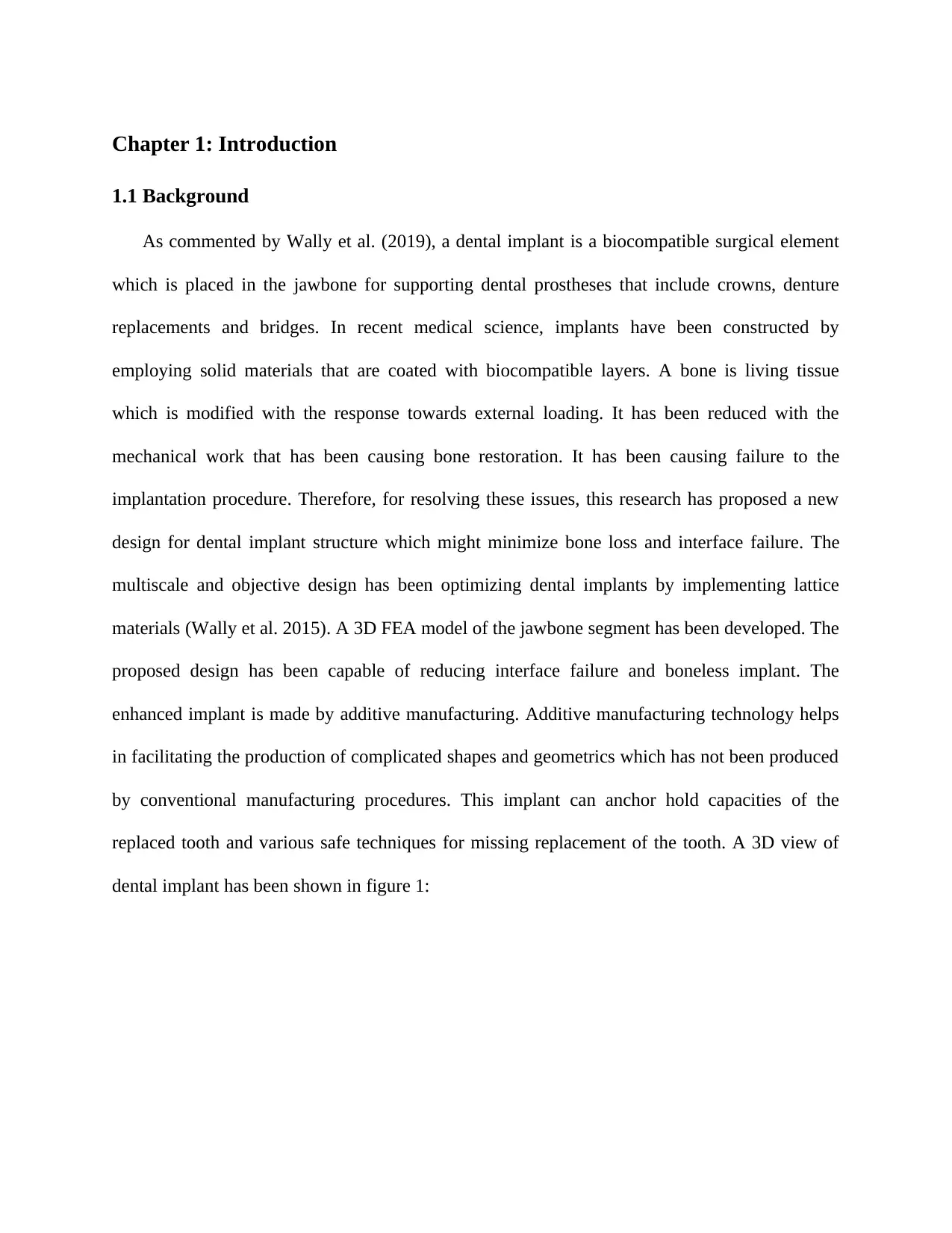
Chapter 1: Introduction
1.1 Background
As commented by Wally et al. (2019), a dental implant is a biocompatible surgical element
which is placed in the jawbone for supporting dental prostheses that include crowns, denture
replacements and bridges. In recent medical science, implants have been constructed by
employing solid materials that are coated with biocompatible layers. A bone is living tissue
which is modified with the response towards external loading. It has been reduced with the
mechanical work that has been causing bone restoration. It has been causing failure to the
implantation procedure. Therefore, for resolving these issues, this research has proposed a new
design for dental implant structure which might minimize bone loss and interface failure. The
multiscale and objective design has been optimizing dental implants by implementing lattice
materials (Wally et al. 2015). A 3D FEA model of the jawbone segment has been developed. The
proposed design has been capable of reducing interface failure and boneless implant. The
enhanced implant is made by additive manufacturing. Additive manufacturing technology helps
in facilitating the production of complicated shapes and geometrics which has not been produced
by conventional manufacturing procedures. This implant can anchor hold capacities of the
replaced tooth and various safe techniques for missing replacement of the tooth. A 3D view of
dental implant has been shown in figure 1:
1.1 Background
As commented by Wally et al. (2019), a dental implant is a biocompatible surgical element
which is placed in the jawbone for supporting dental prostheses that include crowns, denture
replacements and bridges. In recent medical science, implants have been constructed by
employing solid materials that are coated with biocompatible layers. A bone is living tissue
which is modified with the response towards external loading. It has been reduced with the
mechanical work that has been causing bone restoration. It has been causing failure to the
implantation procedure. Therefore, for resolving these issues, this research has proposed a new
design for dental implant structure which might minimize bone loss and interface failure. The
multiscale and objective design has been optimizing dental implants by implementing lattice
materials (Wally et al. 2015). A 3D FEA model of the jawbone segment has been developed. The
proposed design has been capable of reducing interface failure and boneless implant. The
enhanced implant is made by additive manufacturing. Additive manufacturing technology helps
in facilitating the production of complicated shapes and geometrics which has not been produced
by conventional manufacturing procedures. This implant can anchor hold capacities of the
replaced tooth and various safe techniques for missing replacement of the tooth. A 3D view of
dental implant has been shown in figure 1:
⊘ This is a preview!⊘
Do you want full access?
Subscribe today to unlock all pages.

Trusted by 1+ million students worldwide
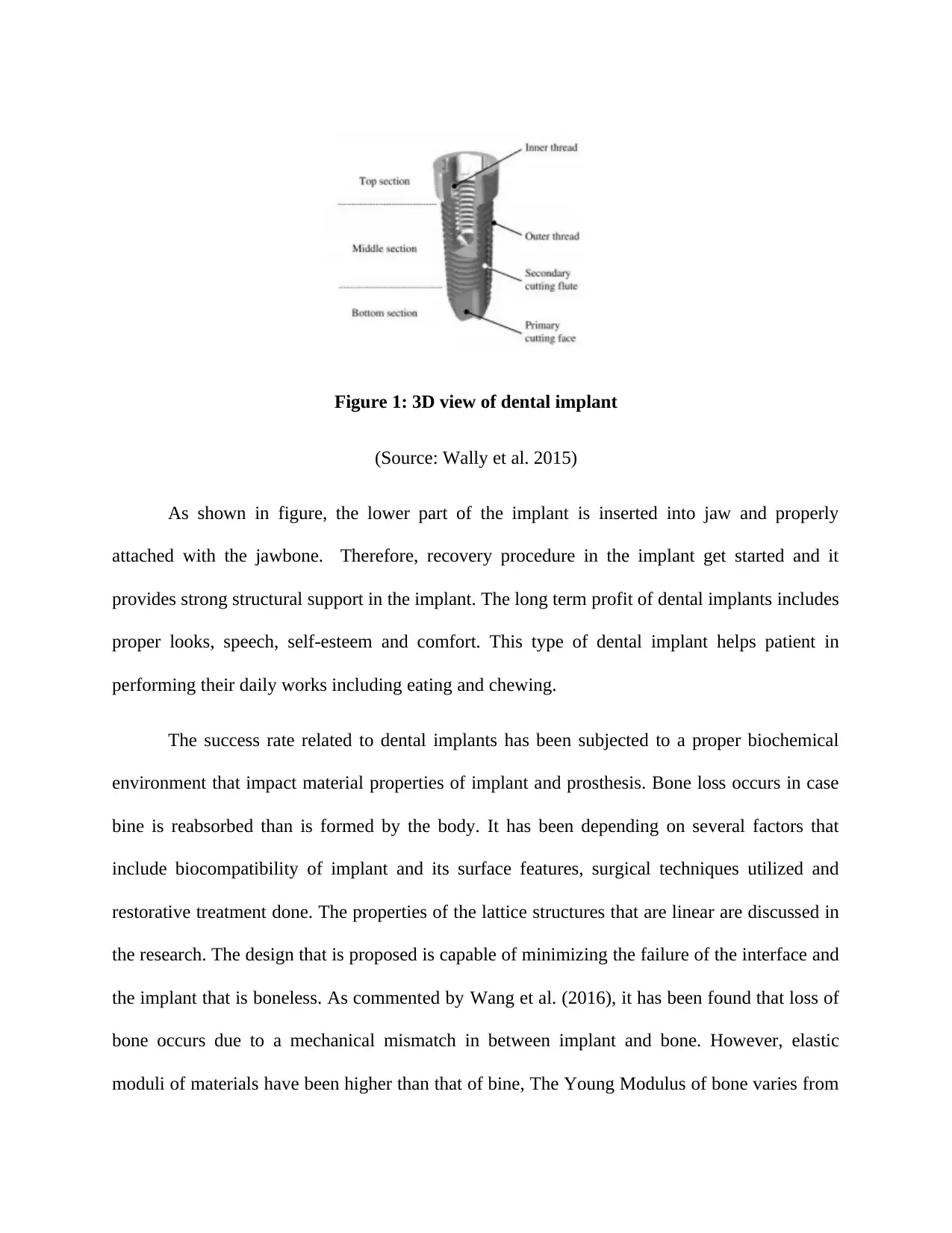
Figure 1: 3D view of dental implant
(Source: Wally et al. 2015)
As shown in figure, the lower part of the implant is inserted into jaw and properly
attached with the jawbone. Therefore, recovery procedure in the implant get started and it
provides strong structural support in the implant. The long term profit of dental implants includes
proper looks, speech, self-esteem and comfort. This type of dental implant helps patient in
performing their daily works including eating and chewing.
The success rate related to dental implants has been subjected to a proper biochemical
environment that impact material properties of implant and prosthesis. Bone loss occurs in case
bine is reabsorbed than is formed by the body. It has been depending on several factors that
include biocompatibility of implant and its surface features, surgical techniques utilized and
restorative treatment done. The properties of the lattice structures that are linear are discussed in
the research. The design that is proposed is capable of minimizing the failure of the interface and
the implant that is boneless. As commented by Wang et al. (2016), it has been found that loss of
bone occurs due to a mechanical mismatch in between implant and bone. However, elastic
moduli of materials have been higher than that of bine, The Young Modulus of bone varies from
(Source: Wally et al. 2015)
As shown in figure, the lower part of the implant is inserted into jaw and properly
attached with the jawbone. Therefore, recovery procedure in the implant get started and it
provides strong structural support in the implant. The long term profit of dental implants includes
proper looks, speech, self-esteem and comfort. This type of dental implant helps patient in
performing their daily works including eating and chewing.
The success rate related to dental implants has been subjected to a proper biochemical
environment that impact material properties of implant and prosthesis. Bone loss occurs in case
bine is reabsorbed than is formed by the body. It has been depending on several factors that
include biocompatibility of implant and its surface features, surgical techniques utilized and
restorative treatment done. The properties of the lattice structures that are linear are discussed in
the research. The design that is proposed is capable of minimizing the failure of the interface and
the implant that is boneless. As commented by Wang et al. (2016), it has been found that loss of
bone occurs due to a mechanical mismatch in between implant and bone. However, elastic
moduli of materials have been higher than that of bine, The Young Modulus of bone varies from
Paraphrase This Document
Need a fresh take? Get an instant paraphrase of this document with our AI Paraphraser
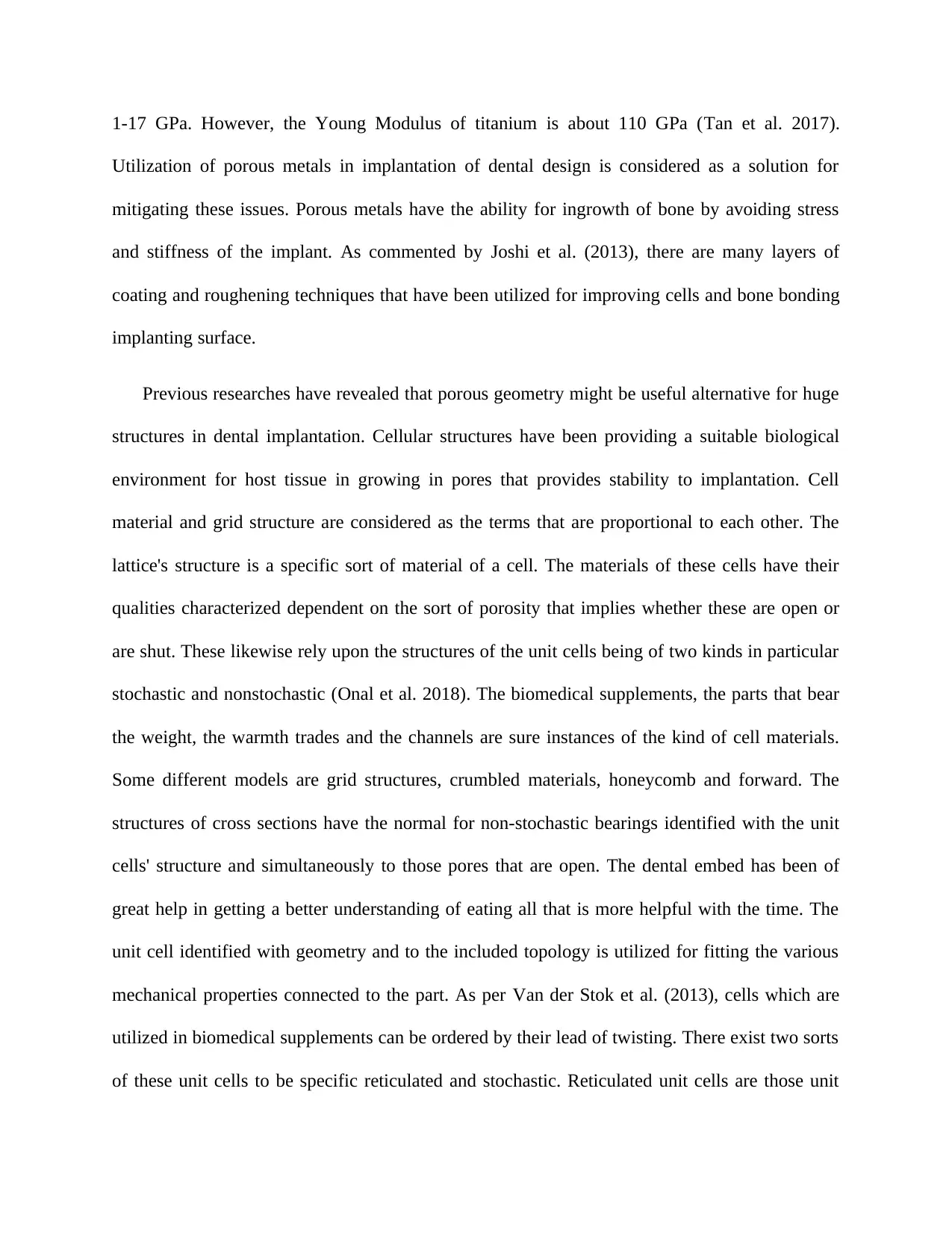
1-17 GPa. However, the Young Modulus of titanium is about 110 GPa (Tan et al. 2017).
Utilization of porous metals in implantation of dental design is considered as a solution for
mitigating these issues. Porous metals have the ability for ingrowth of bone by avoiding stress
and stiffness of the implant. As commented by Joshi et al. (2013), there are many layers of
coating and roughening techniques that have been utilized for improving cells and bone bonding
implanting surface.
Previous researches have revealed that porous geometry might be useful alternative for huge
structures in dental implantation. Cellular structures have been providing a suitable biological
environment for host tissue in growing in pores that provides stability to implantation. Cell
material and grid structure are considered as the terms that are proportional to each other. The
lattice's structure is a specific sort of material of a cell. The materials of these cells have their
qualities characterized dependent on the sort of porosity that implies whether these are open or
are shut. These likewise rely upon the structures of the unit cells being of two kinds in particular
stochastic and nonstochastic (Onal et al. 2018). The biomedical supplements, the parts that bear
the weight, the warmth trades and the channels are sure instances of the kind of cell materials.
Some different models are grid structures, crumbled materials, honeycomb and forward. The
structures of cross sections have the normal for non-stochastic bearings identified with the unit
cells' structure and simultaneously to those pores that are open. The dental embed has been of
great help in getting a better understanding of eating all that is more helpful with the time. The
unit cell identified with geometry and to the included topology is utilized for fitting the various
mechanical properties connected to the part. As per Van der Stok et al. (2013), cells which are
utilized in biomedical supplements can be ordered by their lead of twisting. There exist two sorts
of these unit cells to be specific reticulated and stochastic. Reticulated unit cells are those unit
Utilization of porous metals in implantation of dental design is considered as a solution for
mitigating these issues. Porous metals have the ability for ingrowth of bone by avoiding stress
and stiffness of the implant. As commented by Joshi et al. (2013), there are many layers of
coating and roughening techniques that have been utilized for improving cells and bone bonding
implanting surface.
Previous researches have revealed that porous geometry might be useful alternative for huge
structures in dental implantation. Cellular structures have been providing a suitable biological
environment for host tissue in growing in pores that provides stability to implantation. Cell
material and grid structure are considered as the terms that are proportional to each other. The
lattice's structure is a specific sort of material of a cell. The materials of these cells have their
qualities characterized dependent on the sort of porosity that implies whether these are open or
are shut. These likewise rely upon the structures of the unit cells being of two kinds in particular
stochastic and nonstochastic (Onal et al. 2018). The biomedical supplements, the parts that bear
the weight, the warmth trades and the channels are sure instances of the kind of cell materials.
Some different models are grid structures, crumbled materials, honeycomb and forward. The
structures of cross sections have the normal for non-stochastic bearings identified with the unit
cells' structure and simultaneously to those pores that are open. The dental embed has been of
great help in getting a better understanding of eating all that is more helpful with the time. The
unit cell identified with geometry and to the included topology is utilized for fitting the various
mechanical properties connected to the part. As per Van der Stok et al. (2013), cells which are
utilized in biomedical supplements can be ordered by their lead of twisting. There exist two sorts
of these unit cells to be specific reticulated and stochastic. Reticulated unit cells are those unit
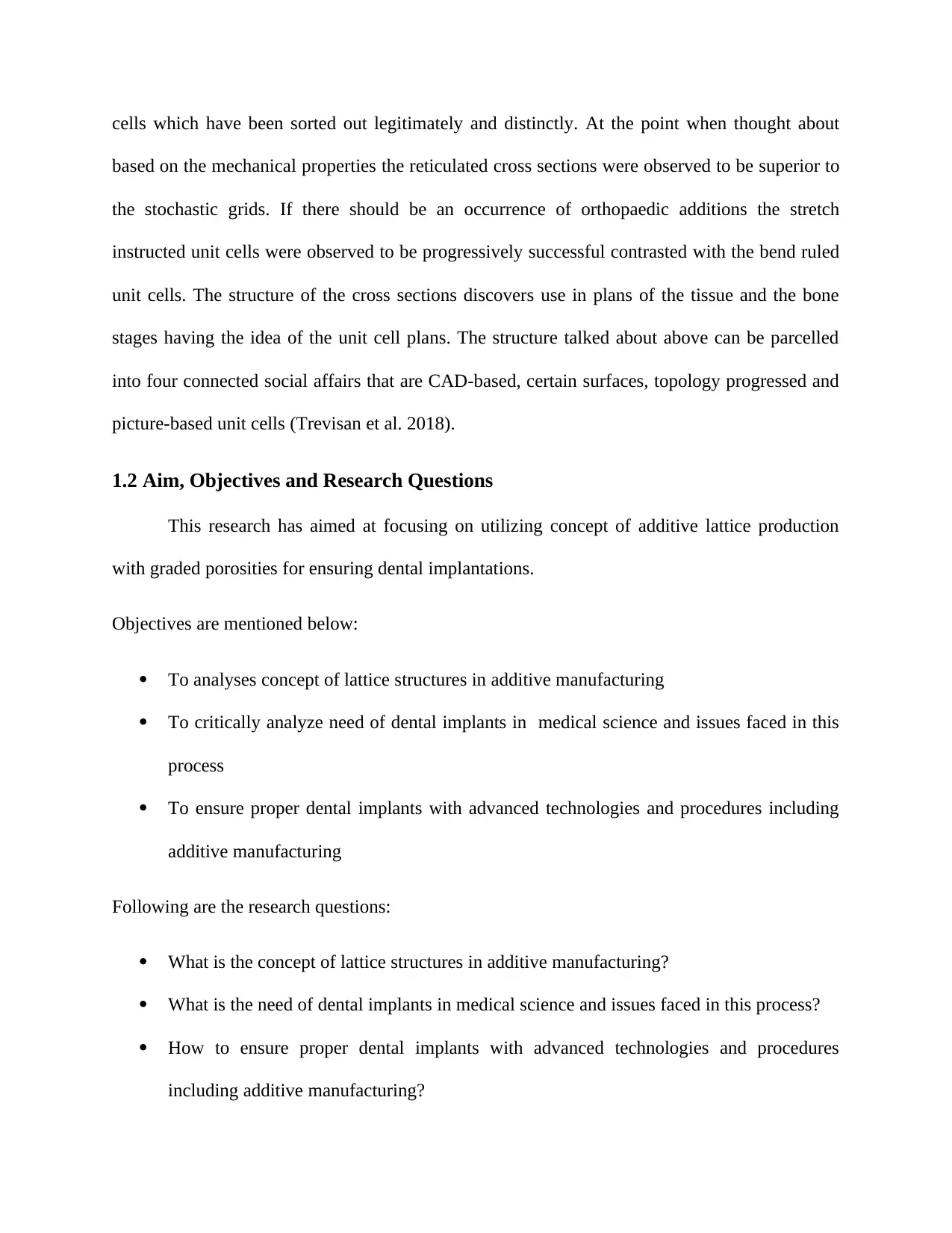
cells which have been sorted out legitimately and distinctly. At the point when thought about
based on the mechanical properties the reticulated cross sections were observed to be superior to
the stochastic grids. If there should be an occurrence of orthopaedic additions the stretch
instructed unit cells were observed to be progressively successful contrasted with the bend ruled
unit cells. The structure of the cross sections discovers use in plans of the tissue and the bone
stages having the idea of the unit cell plans. The structure talked about above can be parcelled
into four connected social affairs that are CAD-based, certain surfaces, topology progressed and
picture-based unit cells (Trevisan et al. 2018).
1.2 Aim, Objectives and Research Questions
This research has aimed at focusing on utilizing concept of additive lattice production
with graded porosities for ensuring dental implantations.
Objectives are mentioned below:
To analyses concept of lattice structures in additive manufacturing
To critically analyze need of dental implants in medical science and issues faced in this
process
To ensure proper dental implants with advanced technologies and procedures including
additive manufacturing
Following are the research questions:
What is the concept of lattice structures in additive manufacturing?
What is the need of dental implants in medical science and issues faced in this process?
How to ensure proper dental implants with advanced technologies and procedures
including additive manufacturing?
based on the mechanical properties the reticulated cross sections were observed to be superior to
the stochastic grids. If there should be an occurrence of orthopaedic additions the stretch
instructed unit cells were observed to be progressively successful contrasted with the bend ruled
unit cells. The structure of the cross sections discovers use in plans of the tissue and the bone
stages having the idea of the unit cell plans. The structure talked about above can be parcelled
into four connected social affairs that are CAD-based, certain surfaces, topology progressed and
picture-based unit cells (Trevisan et al. 2018).
1.2 Aim, Objectives and Research Questions
This research has aimed at focusing on utilizing concept of additive lattice production
with graded porosities for ensuring dental implantations.
Objectives are mentioned below:
To analyses concept of lattice structures in additive manufacturing
To critically analyze need of dental implants in medical science and issues faced in this
process
To ensure proper dental implants with advanced technologies and procedures including
additive manufacturing
Following are the research questions:
What is the concept of lattice structures in additive manufacturing?
What is the need of dental implants in medical science and issues faced in this process?
How to ensure proper dental implants with advanced technologies and procedures
including additive manufacturing?
⊘ This is a preview!⊘
Do you want full access?
Subscribe today to unlock all pages.

Trusted by 1+ million students worldwide

1.3 Research Structure
Chapter 1: Introduction
Chapter 2: Literature Review
Chapter 3: Research Methodology
Chapter 4: Data Findings and Analysis
Chapter 5: Conclusion and Recommendations
Chapter 1: Introduction
Chapter 2: Literature Review
Chapter 3: Research Methodology
Chapter 4: Data Findings and Analysis
Chapter 5: Conclusion and Recommendations
Paraphrase This Document
Need a fresh take? Get an instant paraphrase of this document with our AI Paraphraser
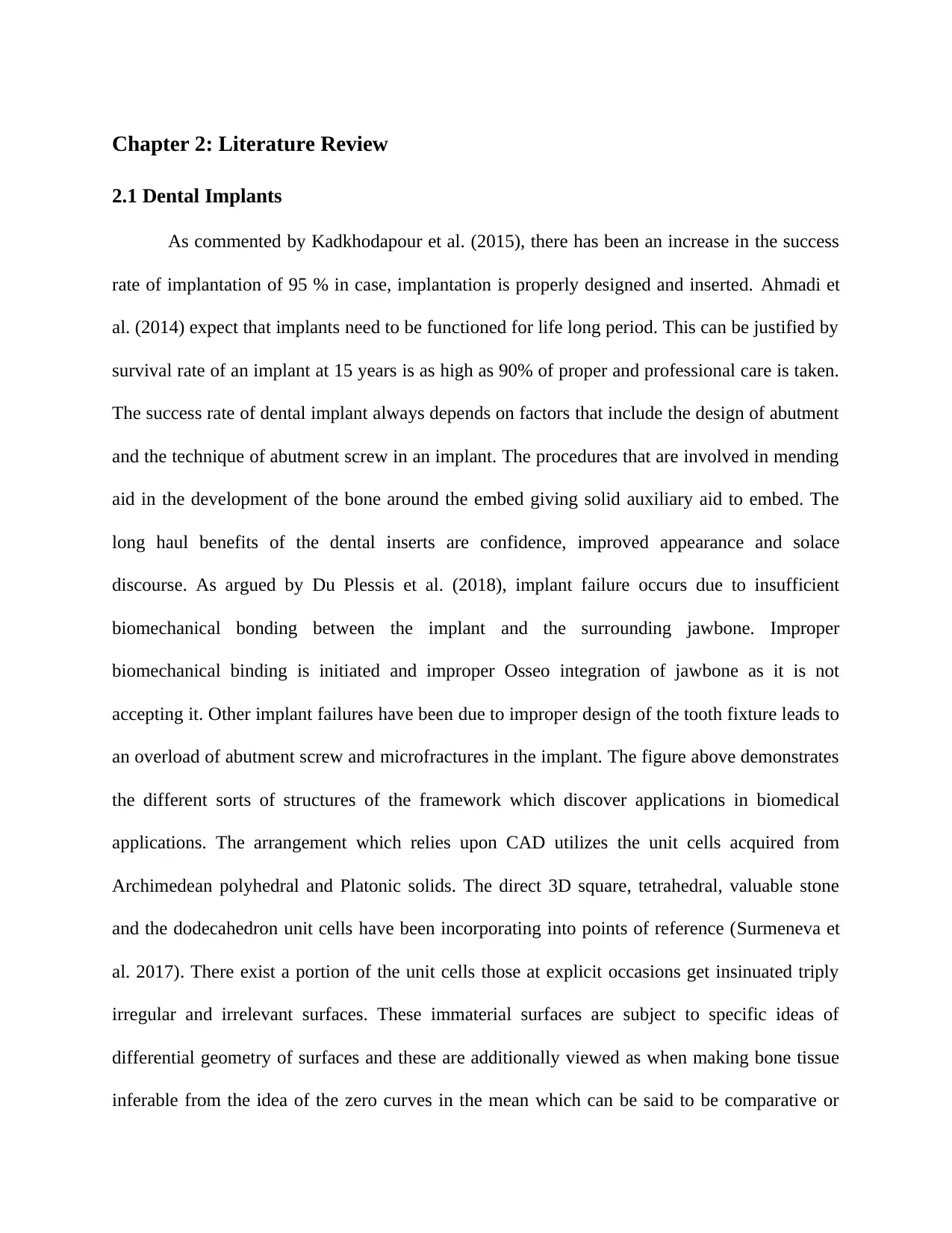
Chapter 2: Literature Review
2.1 Dental Implants
As commented by Kadkhodapour et al. (2015), there has been an increase in the success
rate of implantation of 95 % in case, implantation is properly designed and inserted. Ahmadi et
al. (2014) expect that implants need to be functioned for life long period. This can be justified by
survival rate of an implant at 15 years is as high as 90% of proper and professional care is taken.
The success rate of dental implant always depends on factors that include the design of abutment
and the technique of abutment screw in an implant. The procedures that are involved in mending
aid in the development of the bone around the embed giving solid auxiliary aid to embed. The
long haul benefits of the dental inserts are confidence, improved appearance and solace
discourse. As argued by Du Plessis et al. (2018), implant failure occurs due to insufficient
biomechanical bonding between the implant and the surrounding jawbone. Improper
biomechanical binding is initiated and improper Osseo integration of jawbone as it is not
accepting it. Other implant failures have been due to improper design of the tooth fixture leads to
an overload of abutment screw and microfractures in the implant. The figure above demonstrates
the different sorts of structures of the framework which discover applications in biomedical
applications. The arrangement which relies upon CAD utilizes the unit cells acquired from
Archimedean polyhedral and Platonic solids. The direct 3D square, tetrahedral, valuable stone
and the dodecahedron unit cells have been incorporating into points of reference (Surmeneva et
al. 2017). There exist a portion of the unit cells those at explicit occasions get insinuated triply
irregular and irrelevant surfaces. These immaterial surfaces are subject to specific ideas of
differential geometry of surfaces and these are additionally viewed as when making bone tissue
inferable from the idea of the zero curves in the mean which can be said to be comparative or
2.1 Dental Implants
As commented by Kadkhodapour et al. (2015), there has been an increase in the success
rate of implantation of 95 % in case, implantation is properly designed and inserted. Ahmadi et
al. (2014) expect that implants need to be functioned for life long period. This can be justified by
survival rate of an implant at 15 years is as high as 90% of proper and professional care is taken.
The success rate of dental implant always depends on factors that include the design of abutment
and the technique of abutment screw in an implant. The procedures that are involved in mending
aid in the development of the bone around the embed giving solid auxiliary aid to embed. The
long haul benefits of the dental inserts are confidence, improved appearance and solace
discourse. As argued by Du Plessis et al. (2018), implant failure occurs due to insufficient
biomechanical bonding between the implant and the surrounding jawbone. Improper
biomechanical binding is initiated and improper Osseo integration of jawbone as it is not
accepting it. Other implant failures have been due to improper design of the tooth fixture leads to
an overload of abutment screw and microfractures in the implant. The figure above demonstrates
the different sorts of structures of the framework which discover applications in biomedical
applications. The arrangement which relies upon CAD utilizes the unit cells acquired from
Archimedean polyhedral and Platonic solids. The direct 3D square, tetrahedral, valuable stone
and the dodecahedron unit cells have been incorporating into points of reference (Surmeneva et
al. 2017). There exist a portion of the unit cells those at explicit occasions get insinuated triply
irregular and irrelevant surfaces. These immaterial surfaces are subject to specific ideas of
differential geometry of surfaces and these are additionally viewed as when making bone tissue
inferable from the idea of the zero curves in the mean which can be said to be comparative or
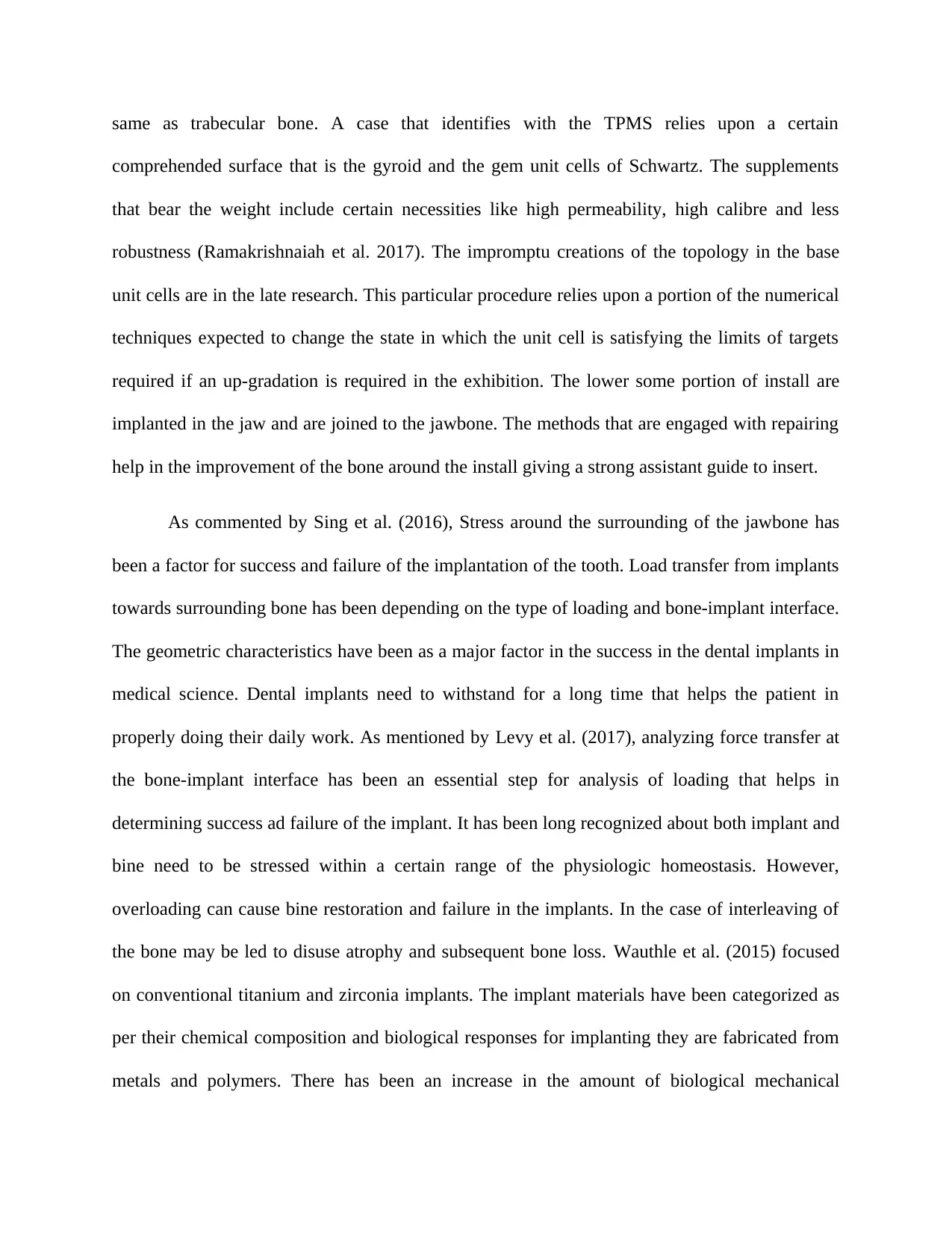
same as trabecular bone. A case that identifies with the TPMS relies upon a certain
comprehended surface that is the gyroid and the gem unit cells of Schwartz. The supplements
that bear the weight include certain necessities like high permeability, high calibre and less
robustness (Ramakrishnaiah et al. 2017). The impromptu creations of the topology in the base
unit cells are in the late research. This particular procedure relies upon a portion of the numerical
techniques expected to change the state in which the unit cell is satisfying the limits of targets
required if an up-gradation is required in the exhibition. The lower some portion of install are
implanted in the jaw and are joined to the jawbone. The methods that are engaged with repairing
help in the improvement of the bone around the install giving a strong assistant guide to insert.
As commented by Sing et al. (2016), Stress around the surrounding of the jawbone has
been a factor for success and failure of the implantation of the tooth. Load transfer from implants
towards surrounding bone has been depending on the type of loading and bone-implant interface.
The geometric characteristics have been as a major factor in the success in the dental implants in
medical science. Dental implants need to withstand for a long time that helps the patient in
properly doing their daily work. As mentioned by Levy et al. (2017), analyzing force transfer at
the bone-implant interface has been an essential step for analysis of loading that helps in
determining success ad failure of the implant. It has been long recognized about both implant and
bine need to be stressed within a certain range of the physiologic homeostasis. However,
overloading can cause bine restoration and failure in the implants. In the case of interleaving of
the bone may be led to disuse atrophy and subsequent bone loss. Wauthle et al. (2015) focused
on conventional titanium and zirconia implants. The implant materials have been categorized as
per their chemical composition and biological responses for implanting they are fabricated from
metals and polymers. There has been an increase in the amount of biological mechanical
comprehended surface that is the gyroid and the gem unit cells of Schwartz. The supplements
that bear the weight include certain necessities like high permeability, high calibre and less
robustness (Ramakrishnaiah et al. 2017). The impromptu creations of the topology in the base
unit cells are in the late research. This particular procedure relies upon a portion of the numerical
techniques expected to change the state in which the unit cell is satisfying the limits of targets
required if an up-gradation is required in the exhibition. The lower some portion of install are
implanted in the jaw and are joined to the jawbone. The methods that are engaged with repairing
help in the improvement of the bone around the install giving a strong assistant guide to insert.
As commented by Sing et al. (2016), Stress around the surrounding of the jawbone has
been a factor for success and failure of the implantation of the tooth. Load transfer from implants
towards surrounding bone has been depending on the type of loading and bone-implant interface.
The geometric characteristics have been as a major factor in the success in the dental implants in
medical science. Dental implants need to withstand for a long time that helps the patient in
properly doing their daily work. As mentioned by Levy et al. (2017), analyzing force transfer at
the bone-implant interface has been an essential step for analysis of loading that helps in
determining success ad failure of the implant. It has been long recognized about both implant and
bine need to be stressed within a certain range of the physiologic homeostasis. However,
overloading can cause bine restoration and failure in the implants. In the case of interleaving of
the bone may be led to disuse atrophy and subsequent bone loss. Wauthle et al. (2015) focused
on conventional titanium and zirconia implants. The implant materials have been categorized as
per their chemical composition and biological responses for implanting they are fabricated from
metals and polymers. There has been an increase in the amount of biological mechanical
⊘ This is a preview!⊘
Do you want full access?
Subscribe today to unlock all pages.

Trusted by 1+ million students worldwide
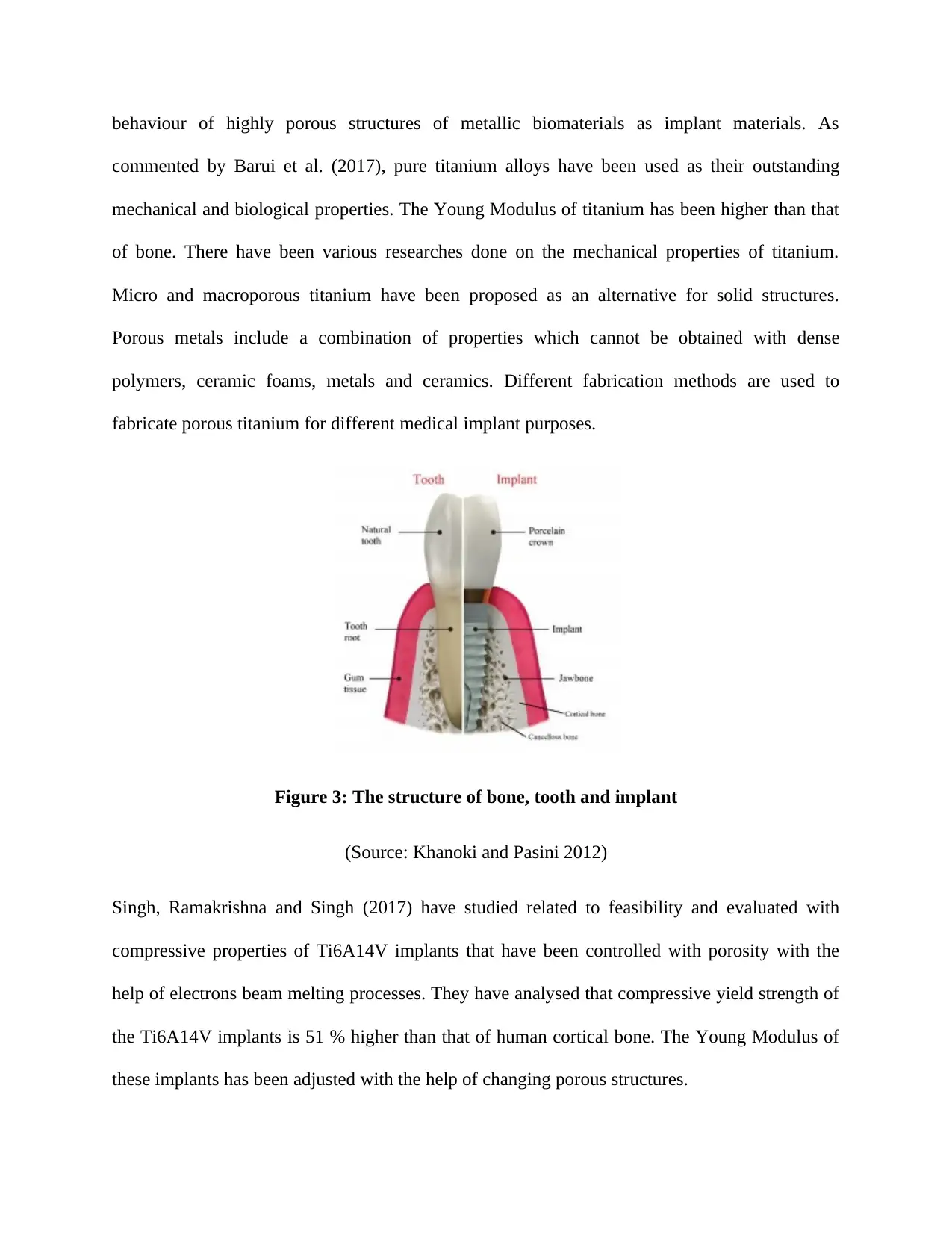
behaviour of highly porous structures of metallic biomaterials as implant materials. As
commented by Barui et al. (2017), pure titanium alloys have been used as their outstanding
mechanical and biological properties. The Young Modulus of titanium has been higher than that
of bone. There have been various researches done on the mechanical properties of titanium.
Micro and macroporous titanium have been proposed as an alternative for solid structures.
Porous metals include a combination of properties which cannot be obtained with dense
polymers, ceramic foams, metals and ceramics. Different fabrication methods are used to
fabricate porous titanium for different medical implant purposes.
Figure 3: The structure of bone, tooth and implant
(Source: Khanoki and Pasini 2012)
Singh, Ramakrishna and Singh (2017) have studied related to feasibility and evaluated with
compressive properties of Ti6A14V implants that have been controlled with porosity with the
help of electrons beam melting processes. They have analysed that compressive yield strength of
the Ti6A14V implants is 51 % higher than that of human cortical bone. The Young Modulus of
these implants has been adjusted with the help of changing porous structures.
commented by Barui et al. (2017), pure titanium alloys have been used as their outstanding
mechanical and biological properties. The Young Modulus of titanium has been higher than that
of bone. There have been various researches done on the mechanical properties of titanium.
Micro and macroporous titanium have been proposed as an alternative for solid structures.
Porous metals include a combination of properties which cannot be obtained with dense
polymers, ceramic foams, metals and ceramics. Different fabrication methods are used to
fabricate porous titanium for different medical implant purposes.
Figure 3: The structure of bone, tooth and implant
(Source: Khanoki and Pasini 2012)
Singh, Ramakrishna and Singh (2017) have studied related to feasibility and evaluated with
compressive properties of Ti6A14V implants that have been controlled with porosity with the
help of electrons beam melting processes. They have analysed that compressive yield strength of
the Ti6A14V implants is 51 % higher than that of human cortical bone. The Young Modulus of
these implants has been adjusted with the help of changing porous structures.
Paraphrase This Document
Need a fresh take? Get an instant paraphrase of this document with our AI Paraphraser
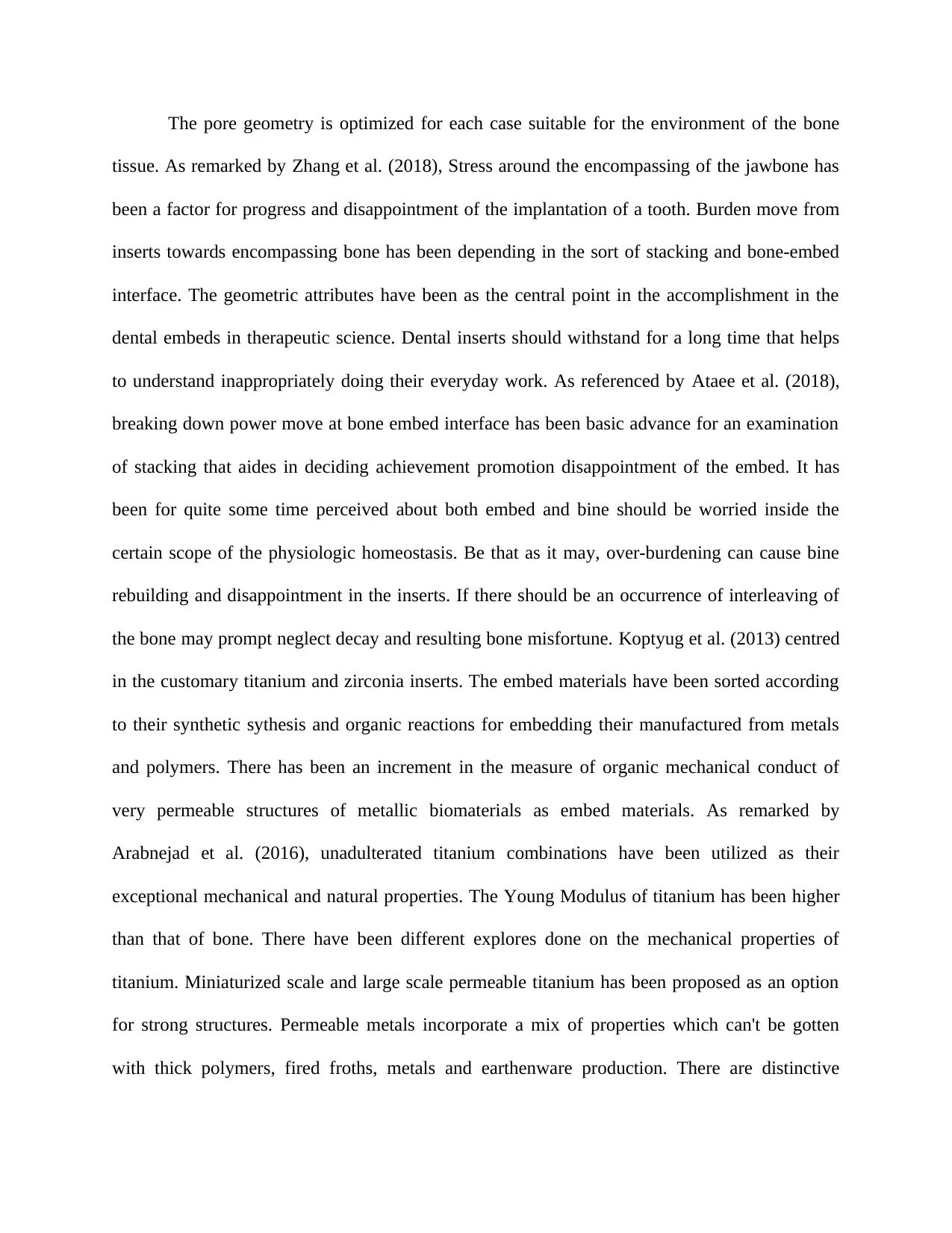
The pore geometry is optimized for each case suitable for the environment of the bone
tissue. As remarked by Zhang et al. (2018), Stress around the encompassing of the jawbone has
been a factor for progress and disappointment of the implantation of a tooth. Burden move from
inserts towards encompassing bone has been depending in the sort of stacking and bone-embed
interface. The geometric attributes have been as the central point in the accomplishment in the
dental embeds in therapeutic science. Dental inserts should withstand for a long time that helps
to understand inappropriately doing their everyday work. As referenced by Ataee et al. (2018),
breaking down power move at bone embed interface has been basic advance for an examination
of stacking that aides in deciding achievement promotion disappointment of the embed. It has
been for quite some time perceived about both embed and bine should be worried inside the
certain scope of the physiologic homeostasis. Be that as it may, over-burdening can cause bine
rebuilding and disappointment in the inserts. If there should be an occurrence of interleaving of
the bone may prompt neglect decay and resulting bone misfortune. Koptyug et al. (2013) centred
in the customary titanium and zirconia inserts. The embed materials have been sorted according
to their synthetic sythesis and organic reactions for embedding their manufactured from metals
and polymers. There has been an increment in the measure of organic mechanical conduct of
very permeable structures of metallic biomaterials as embed materials. As remarked by
Arabnejad et al. (2016), unadulterated titanium combinations have been utilized as their
exceptional mechanical and natural properties. The Young Modulus of titanium has been higher
than that of bone. There have been different explores done on the mechanical properties of
titanium. Miniaturized scale and large scale permeable titanium has been proposed as an option
for strong structures. Permeable metals incorporate a mix of properties which can't be gotten
with thick polymers, fired froths, metals and earthenware production. There are distinctive
tissue. As remarked by Zhang et al. (2018), Stress around the encompassing of the jawbone has
been a factor for progress and disappointment of the implantation of a tooth. Burden move from
inserts towards encompassing bone has been depending in the sort of stacking and bone-embed
interface. The geometric attributes have been as the central point in the accomplishment in the
dental embeds in therapeutic science. Dental inserts should withstand for a long time that helps
to understand inappropriately doing their everyday work. As referenced by Ataee et al. (2018),
breaking down power move at bone embed interface has been basic advance for an examination
of stacking that aides in deciding achievement promotion disappointment of the embed. It has
been for quite some time perceived about both embed and bine should be worried inside the
certain scope of the physiologic homeostasis. Be that as it may, over-burdening can cause bine
rebuilding and disappointment in the inserts. If there should be an occurrence of interleaving of
the bone may prompt neglect decay and resulting bone misfortune. Koptyug et al. (2013) centred
in the customary titanium and zirconia inserts. The embed materials have been sorted according
to their synthetic sythesis and organic reactions for embedding their manufactured from metals
and polymers. There has been an increment in the measure of organic mechanical conduct of
very permeable structures of metallic biomaterials as embed materials. As remarked by
Arabnejad et al. (2016), unadulterated titanium combinations have been utilized as their
exceptional mechanical and natural properties. The Young Modulus of titanium has been higher
than that of bone. There have been different explores done on the mechanical properties of
titanium. Miniaturized scale and large scale permeable titanium has been proposed as an option
for strong structures. Permeable metals incorporate a mix of properties which can't be gotten
with thick polymers, fired froths, metals and earthenware production. There are distinctive
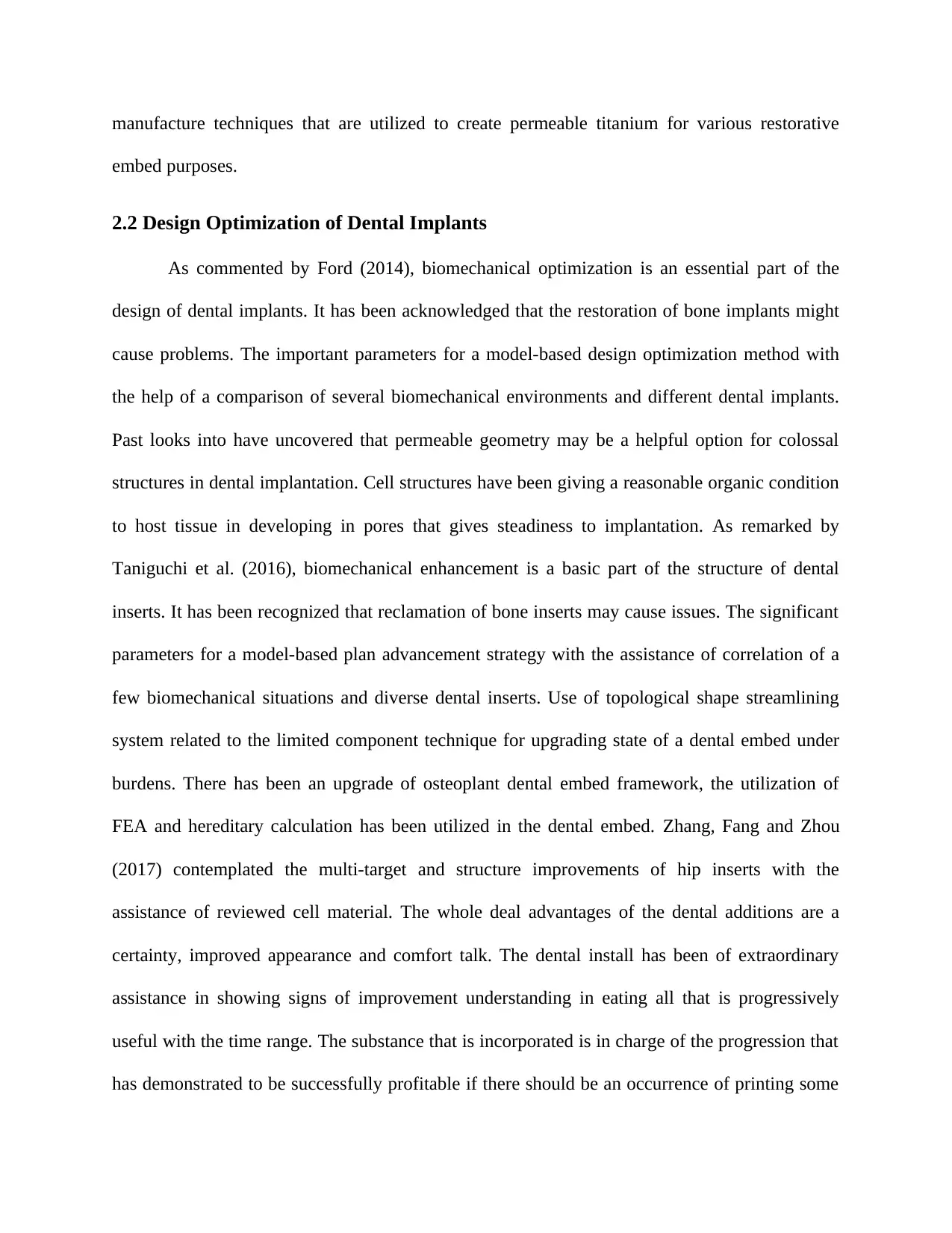
manufacture techniques that are utilized to create permeable titanium for various restorative
embed purposes.
2.2 Design Optimization of Dental Implants
As commented by Ford (2014), biomechanical optimization is an essential part of the
design of dental implants. It has been acknowledged that the restoration of bone implants might
cause problems. The important parameters for a model-based design optimization method with
the help of a comparison of several biomechanical environments and different dental implants.
Past looks into have uncovered that permeable geometry may be a helpful option for colossal
structures in dental implantation. Cell structures have been giving a reasonable organic condition
to host tissue in developing in pores that gives steadiness to implantation. As remarked by
Taniguchi et al. (2016), biomechanical enhancement is a basic part of the structure of dental
inserts. It has been recognized that reclamation of bone inserts may cause issues. The significant
parameters for a model-based plan advancement strategy with the assistance of correlation of a
few biomechanical situations and diverse dental inserts. Use of topological shape streamlining
system related to the limited component technique for upgrading state of a dental embed under
burdens. There has been an upgrade of osteoplant dental embed framework, the utilization of
FEA and hereditary calculation has been utilized in the dental embed. Zhang, Fang and Zhou
(2017) contemplated the multi-target and structure improvements of hip inserts with the
assistance of reviewed cell material. The whole deal advantages of the dental additions are a
certainty, improved appearance and comfort talk. The dental install has been of extraordinary
assistance in showing signs of improvement understanding in eating all that is progressively
useful with the time range. The substance that is incorporated is in charge of the progression that
has demonstrated to be successfully profitable if there should be an occurrence of printing some
embed purposes.
2.2 Design Optimization of Dental Implants
As commented by Ford (2014), biomechanical optimization is an essential part of the
design of dental implants. It has been acknowledged that the restoration of bone implants might
cause problems. The important parameters for a model-based design optimization method with
the help of a comparison of several biomechanical environments and different dental implants.
Past looks into have uncovered that permeable geometry may be a helpful option for colossal
structures in dental implantation. Cell structures have been giving a reasonable organic condition
to host tissue in developing in pores that gives steadiness to implantation. As remarked by
Taniguchi et al. (2016), biomechanical enhancement is a basic part of the structure of dental
inserts. It has been recognized that reclamation of bone inserts may cause issues. The significant
parameters for a model-based plan advancement strategy with the assistance of correlation of a
few biomechanical situations and diverse dental inserts. Use of topological shape streamlining
system related to the limited component technique for upgrading state of a dental embed under
burdens. There has been an upgrade of osteoplant dental embed framework, the utilization of
FEA and hereditary calculation has been utilized in the dental embed. Zhang, Fang and Zhou
(2017) contemplated the multi-target and structure improvements of hip inserts with the
assistance of reviewed cell material. The whole deal advantages of the dental additions are a
certainty, improved appearance and comfort talk. The dental install has been of extraordinary
assistance in showing signs of improvement understanding in eating all that is progressively
useful with the time range. The substance that is incorporated is in charge of the progression that
has demonstrated to be successfully profitable if there should be an occurrence of printing some
⊘ This is a preview!⊘
Do you want full access?
Subscribe today to unlock all pages.

Trusted by 1+ million students worldwide
1 out of 37
Related Documents
Your All-in-One AI-Powered Toolkit for Academic Success.
+13062052269
info@desklib.com
Available 24*7 on WhatsApp / Email
![[object Object]](/_next/static/media/star-bottom.7253800d.svg)
Unlock your academic potential
Copyright © 2020–2025 A2Z Services. All Rights Reserved. Developed and managed by ZUCOL.



